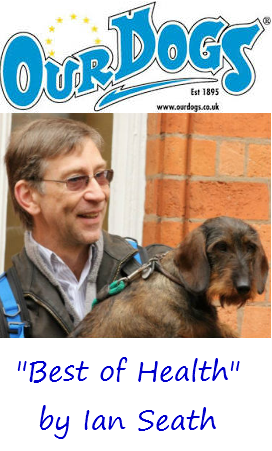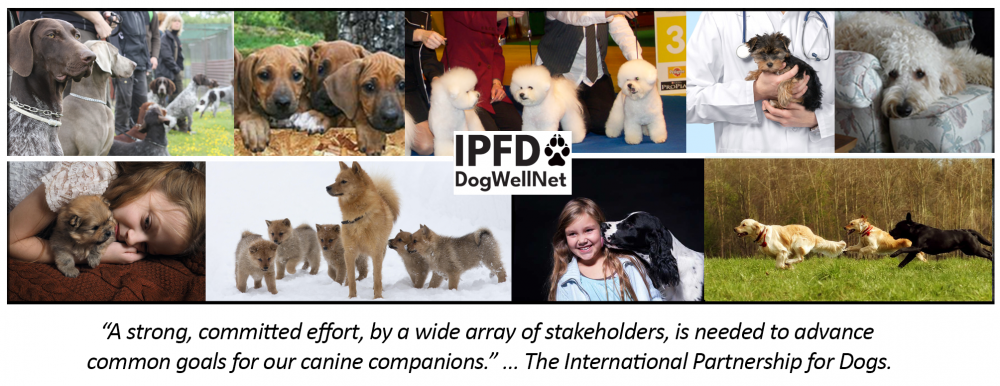The Big Picture - in the Dog World as a Whole and for your next Breeding Decision
The Big Picture - in the Dog World as a Whole and for your next Breeding Decision
Note: This topic was prompted partly by IPFD's participation in the Canine Health Summit (videos available) put on by Embark Veterinary. See our Q&A article on breeding and genetics topics here.
My last blog in 2020 was on the Big Picture in the dog world - it was about Reframing Discussions, globally. Based on our document...the blog describes a webinar and links to presentations discussing all the stakeholders in dog health and welfare and their individual and collective responsibilities.

IPFD's great friend and collaborator, Ian Seath has started 2021 also looking at the Big Picture - and the consequences of ignoring it.
2021: Time to see the bigger picture – my January “Best of Health” article - please, read it!
Ian gives great examples from the world of dogs and parallels with the Covid situation.
I'd like to focus on his comments on health testing, i.e. that a narrow focus on available DNA tests without careful consideration of other health concerns in the breed or line, getting hung up on one mutation and overusing 'clear' sires, and falling in with the marketing ploy that doing all sort of tests is evidence that you are a 'good breeder' are not best practices for breeders.
I have just published another blog entitled 'Inbreeding vs. Linebreeding: Let's be Perfectly Clear' where I discuss that topic in the context of the 'art and science' of dog breeding.
I worry that not only have many people strayed from an adequate focus on the Big Picture,
they may have also dropped common sense as a key component of decision making.
Why do people struggle with really embracing the Big Picture or bringing the broader context into decision-making?
Do people shut down when presented with complex problems? Can they just not be bothered to think that hard? Are they pressed for time?
Maybe it is 'yes' to all of these. But sometimes it is because they just want to do what they want to do and not be faced with a wider responsibility.
For example, when legislators come out with dramatic regulations that do not take into account the full situation and are therefore unlikely to fix the real problem and/or likely to have unintended consequences - was it really an oversight or an accident? Or are they mainly focused on an immediate impact and not concerned with long term effectiveness? Do they admit this - at least to themselves?
When breeders focus on simple solutions - does that reflect a lack of understanding or is it wishful thinking? For example, wouldn't it be great if just doing DNA tests would discharge their responsibility as a 'good breeder'?
Everyone seems to be looking for a silver bullet, simple instructions, black and white do's and don'ts when, in fact, we all know that health, reproduction, mating of dogs, long-term breeding strategies, etc. involve many aspects of humans, animals, biology, genetics...and the one thing it is not and never will be is SIMPLE! And when things go wrong, it hurts people, dogs, and the dog world.
One of the issues raised in the webinar on Reframing Discussions is that even within stakeholder groups there is a wide spectrum of individuals and attitudes, beliefs and actions. And that variability is magnified across countries and cultures. It is often difficult for those with a passionate commitment to their own hobby, lifestyle, and relationship with animals to understand and accept the views of others. Consciously or unconsciously. And this leads to judgmental behaviour and rifts.
Although it is often a challenge, I try hard to be non-judgmental. It is very clear to me that how dogs and dog breeding is approached, embraced, and regulated even within the show world is very different across regions, e.g., the USA vs. Sweden. I can understand and accept that some have a passionate commitment that dogs are sentient beings with rights (almost) equal to humans while at the same time there are others who 'love dogs' and yet see them as property. That is just the way it is. There is not - and never will be - one ideal for dog breeding; no one definition of best practices.
What frustrates me most, however, is when people say one thing, and do something different. Particularly, when their action or inaction leads to suffering - theirs, that of those who buy their puppies, and especially of the dogs themselves. As the popular saying goes, paraphrased, you cannot keep doing things the same way and expect a different outcome. You cannot do linebreeding and increase genetic diversity. It is extremely unlikely that you can make breeding decisions to maximize the likelihood of a win in the show ring and achieve optimal health and longevity in all your dogs, or the breed. You cannot breed dogs with extreme conformation and think their health and welfare will not be affected.
As I talk about in the blog on inbreeding, what I hope for is for people to be perfectly clear. It is obvious that individuals and groups, to varying levels across and within countries or within breeds, have come to accept the impacts - for better and worse - that have happened due to selective breeding. Perhaps most feel that the good outweighs the harm, driven by their underlying attitudes and beliefs. Regardless, they accept the situation, they live with it, they may celebrate the good and lament the not so good. Some do not accept it and drop out of breeding or showing. Others may come in to the sport simply accepting the way it is, that challenges are 'normal for the breed'. When I ask breeders to be 'perfectly clear' I am asking them to look at the Big Picture, and really evaluate where they are in it. To be aware of how they function, how they make decisions, and be realistic about the outcomes. Accept that, in the main, barring unfortunate accidents, what you see in your breeds is what people wanted/prioritized in breeding. If you and your club say you want longer-lived dogs with less cancer and that is not happening - it likely means people are not truly prioritizing those goals. Just to be clear.
And of course, this is directed at breeders mainly associated with the dog exhibition world. And we are increasingly aware that in many countries, that group produces a minority of the dogs that end up in pet homes. However, challenges in that regard do not release anyone in the 'Fancy' or show world from their responsibility to their dogs, their breeds and dogs in general. Leadership is needed - to benefit all dogs everywhere.
There are not simply either good or bad breeders - there are multiple ways to classify those who produce and sell dogs.
But for this and some other issues in dog health and welfare we will be more effective at implementing change if we accept that even if we cannot perfectly define 'best' we can probably identify better vs. questionable, and especially some unacceptable practices, attitudes, or characteristics. Then we can eliminate the latter, and promote the positives.
 Donate
Donate

0 Comments
Recommended Comments
There are no comments to display.